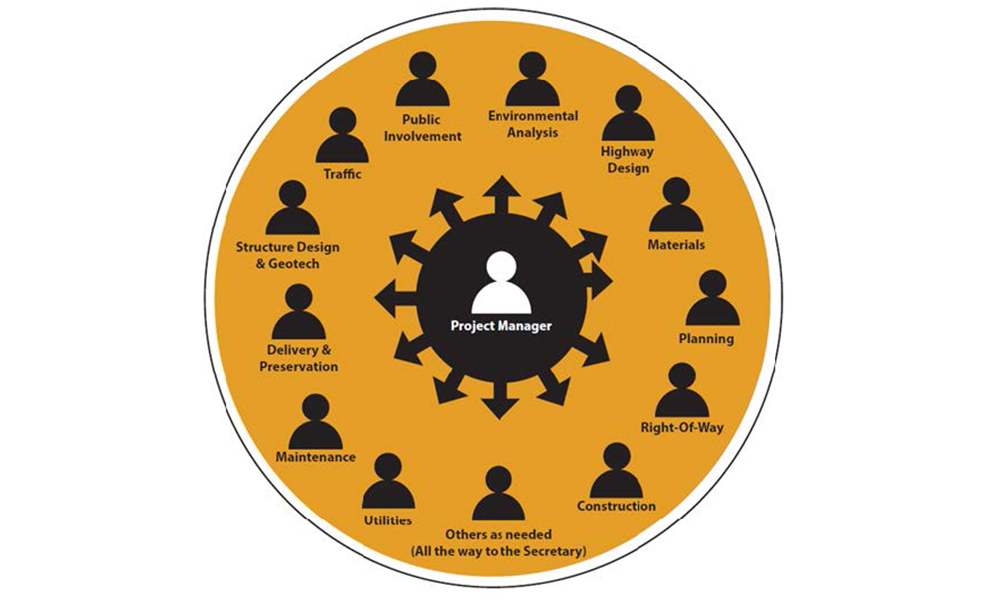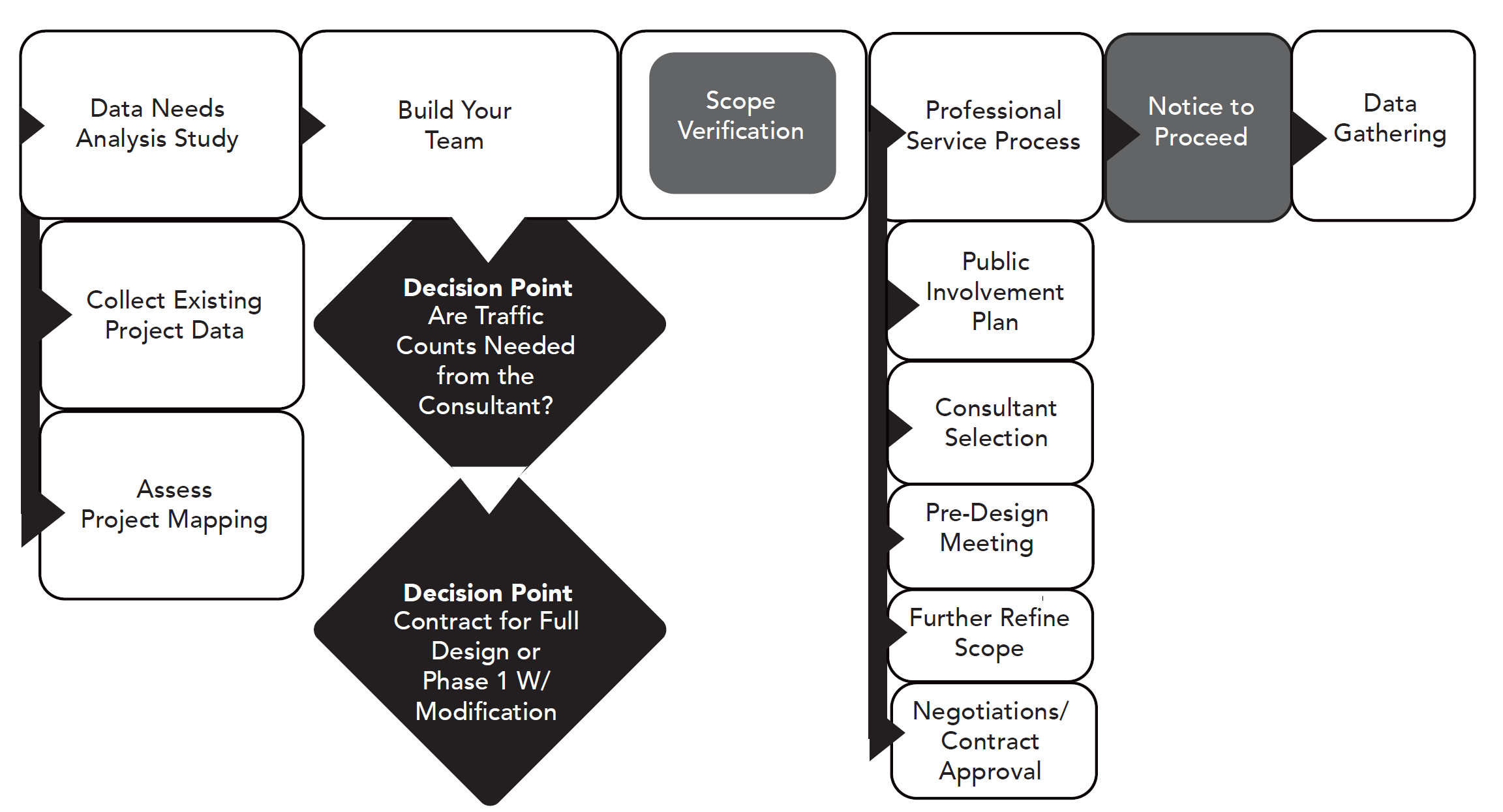Search for articles or browse our knowledge portal by topic.
Build Your Team

Based on the resource determination and identified project needs, the PDM or PM should assemble an appropriate PDT. The PDT includes core preconstruction personnel, representatives from other functions (e.g., construction, operations, and traffic), and the Central Office Highway Design Location Engineer, at a minimum. The team should utilize SMEs as required. The PDM seeks to ensure the consistency of the Design Staff workload, while also building a PDT whose expertise and availability can accomplish project goals in a timely manner. For example, if the District Design Staff are overcommitted, design activities could be assigned to other internal resources, statewide consultant services, or consultant services selected through the Division of Professional Services. Issues that can influence PDT selection include:
• Project Schedule / Milestones
• Project Budget
• Project Complexity
• Identified Performance Issues
• Difficulty Obtaining ROW
•Environmental Impacts & Mitigation
• Utility Relocation
The fiscal year in which the ROW and construction processes will be initiated is critical for deciding how to build the PDT. The schedule is typically prepared around this milestone date. Fast-track or high-priority projects assigned to the Districts may also influence the schedules of ongoing projects.
The Highway Design Guidance Manual (HD-205) discusses consultant administration.
Central Office Support: The Highway Design Location Engineer provides technical support and serves as a liaison between the District Design Staff, the Division of Highway Design, other Central Office divisions, and the FHWA. The Location Engineer also helps provide budget, scope, and schedule oversight to the project team.
Traffic data are one of the most important factors in highway project design and influence many decisions, such as number of lanes, roadway geometrics, and the need for turn lanes. Traffic data also shape the content of a project’s Purpose and Need statement. If after reviewing the existing traffic information the PDM deems additional traffic data are needed, the PDM should consult the Division of Planning to determine if traffic counts will be conducted by the prime design-engineering consultant. If so, this work activity should be included in the project’s Request for Proposals (RFP).
1b. Contract for Full Design or Phase 1 with Modification
When consultant contracts are used for design, more complex projects are regularly contracted with two phases. Phase 1 is the conceptual design phase. During this phase, alternatives are studied and one is chosen as the preferred solution. Phase 2 is the final design phase, during which the selected alternative is documented in plans and specifications so that ROW can be purchased, utilities addressed, and road construction commence. On complex projects, it may be difficult to assess the amount of effort and work needed for Phase 2. Therefore, a contract is negotiated and awarded for Phase 1. Once Phase 1 contract terms are fulfilled, a modification to the existing contract can be negotiated and awarded for Phase 2.
Milestone with Federal Approval
As soon as possible after project authorization, the PM and District Environmental Coordinator (DEC) should consider potential environmental impacts in the project area. On Federal-aid projects with an anticipated NEPA document of Categorical Exclusion (CE) Level 3 or above, a Scope Verification Meeting should be held to discuss the project scope and probable environmental impacts. The purpose of a Scope Verification Meeting is to bring together key members of the PDT (e.g., PM, FHWA, Environmental SMEs, and other team members) before the Pre-Design Conference to discuss work that needs to be initiated and, especially, what level of NEPA document should be pursued. As the level of NEPA document increases, so does the time, effort, and cost of the environmental studies. Neither KYTC nor the FHWA want to perform unnecessary work. Their focus should be restricted to identifying a project development path which pairs the appropriate level of environmental study with a timely project delivery schedule. The Scope Verification Meeting helps ensure that all team members concur with the planned level of preliminary engineering and environmental work.
The Scope Verification Meeting is typically conducted between the advertisement for Professional Services and the Pre-Design Conference. Timing of the meeting is important, to ensure that all parties agree with the scope of the work to be tasked to the consultant prior to the Pre-Design Meeting. The Scope Verification Meeting may be held prior to advertisement if enough information about potential impacts is available.
Red Flag
On challenging highway projects, as Phase 1 progresses, it is possible the scope will evolve from what was originally envisioned at project initiation. A change in scope may affect the type of environmental document needed — the document level could increase or decrease. In these cases, the PM will identify the project issues to the PDT (especially the SMEs), discuss the probable environmental impacts associated with these changes, and determine if a different environmental document type is warranted.
If during the development of the environmental document the PM and SMEs determine that environmental impacts are greater than originally believed, a higher-level environmental document may need to be prepared. Depending upon the environmental work required, scope of the public comments received, and whether additional alternatives or studies are required, development of the environmental document may require additional time. This may negatively impact the project schedule.
If consultant services will be used in project development, the Division of Professional Services assists the PM in advertising for services and securing contracts. The Division of Professional Services also helps the PM throughout the duration of contracts by processing consultant pay estimates for payment and monitoring consultants.
The PDM should be involved in a project’s pre-design activities and will likely know from its inception whether consultants will be responsible for project development activities. If consultants are to undertake project development activities, the PDM or PM should begin to prepare consultant design fee estimates well before the Pre-Design Meeting is held. Design fee estimates are often based on a percentage of the construction estimate. For example, design fees on large projects could range from 10% to 15% of the construction estimate. For small projects, such as a bridge replacement, fees can run between 20% and 50% of the construction estimate. The Design Funds allocated for the project are based on these early estimates. A final Design Fund estimate can be obtained by summing the consultant design fee, administrative costs, and KYTC’s costs. Consultant design fee estimates are adjusted throughout the beginning stages of the project. Developing production-hour estimates before the Pre-Design Meeting is useful for determining the consultant fee. Production hour estimates may be revised after the Pre-Design Meeting or if the scope is refined.
The Division of Professional Services webpage has tools and guidance available, including the Professional Services Guidance Manual. Guidance on the administration of consultant contracts is available in the Highway Design Guidance Manual (HD-205).
Red Flag
A limited number of projects can be advertised in the Division of Professional Services’ monthly procurement bulletin. A PM should contact the Division of Professional Services as soon they know consultant services are needed and work with Division staff to start the process. Otherwise, a project could experience delays as a result of waiting to complete the consultant selection process.
To begin the consultant selection process, the Division of Professional Services needs a RFP for a Professional Services Contract. The PM is responsible creating the RFP. A well-written RFP facilitates the selection of the best qualified firm to perform engineering and engineering-related services. Sufficient time should be allocated for RFP creation and review. The amount of time required depends on the RFP’s complexity and can range from less than one day to several weeks if a review is necessary.

A critical element of all projects, public involvement encompasses more than a single meeting or hearing near the end of the project development process. It should begin early in the project and remain ongoing throughout. To avoid, minimize, and mitigate impacts, as well as to narrow the range of alternatives, it is essential to understand the values of the community impacted by a project. Opinions expressed by the public are important considerations in the transportation decision-making process.
Public involvement needs can vary significantly between projects. For example, on projects where several alternatives are under consideration or projects with heightened controversy, more public meetings may be necessary. Understanding the tradeoffs and constraints associated with each alternative is critical for informing the public and increasing the likelihood of public acceptance. Community awareness of the tradeoffs and constraints involved in the process should encourage public acceptance of the project. Early public involvement lets community members offer critical insights about the project’s goals, needs, and its effects on the community.
As early in the Project Development Phase as possible, the PM, DEC, and District Public Information Officer (PIO) should discuss public involvement strategies. Specifically, they must determine whether a formal public involvement plan (PIP) or an informal plan will be used on the project. Consideration should be given to developing a PIP for every project advanced through project development. On projects that require an EIS a formal PIP is mandatory.
A plan’s content should be tailored to individual project needs. The PIP may include items or activities ranging from individual property owner contacts on small projects to a series of public involvement meetings or public hearings on more complex projects. Some PIPs may prescribe the formation of a citizens advisory committee. The purpose of such a committee is to involve many property owners or special interest groups when significant environmental issues or concerns must be addressed. It is critical to develop a PIP that facilitates communication between KYTC and the public so the Cabinet can make the best transportation decision.
The PDT should develop an outline of the PIP early in the project development phase. The plan must include any federally required public hearings. Supplemental public involvement meetings that will contribute to better decisions on the location or detail of a project may be included as well. The plan may be modified as the project advances, and it should be reviewed by the PDT at critical stages in project development. The PIP should describe the specific methods that will be used to conduct public outreach, such as telephone surveys, newsletters, social media, websites, and focus groups.
For more information on public involvement and meetings, see the Highway Design Guidance Manual (HD-600).
Red Flag
Before the Pre-Design Meeting the PM needs to estimate the extent of public involvement. In doing so, public involvement can be scoped and included in the contract.
A consultant selection committee determines which consultant is offered a contract for a specific project; see the Professional Services Guidance Manual (PS-15-04). Because the procurement and contracting process can take several months, the PM should account for it when developing a project schedule.
Once a consultant is selected, the PM schedules a Pre-Design Meeting (generally within 10 business days of selection) and invites the appropriate SMEs. During a Pre-Design Meeting, project data are reviewed to refine the project’s purpose and need, review the consultant’s scope of work, and discuss proposed work units for the consultant contract. Exhibit 200-10 in the Highway Design Guidance Manual provides sample minutes for a pre-design conference.
The PM, assisted by the PDT, and the consultant will further investigate the project scope prior to determining effort and duration of the work activities. Major discrepancies, issues, or gaps between proposed work units and/or hours are resolved by the Division of Professional Services. If legitimate issues arise with the scope or schedule during contract negotiations, the PM may need to refine both. Examples of legitimate issues include identification of an environmentally sensitive issue, a major utility conflict, ROW challenge, applicable performance measures, and unforeseen needs not incorporated into the original scope and schedule. The PM should check with the State Highway Engineer’s Office, CDE, Location Engineer, and possibly the sponsor to resolve any major issues.
Red Flag
If the refined scope requires the consultant to do additional work on a project, more time or design funding may be needed. The PM should keep in mind that additional time or funding requests may jeopardize on-schedule project completion. They should be judicious when considering significant changes to the project scope.
The Division of Professional Services determines which types of negotiations are appropriate. It then coordinates those negotiations with the PM and consultant.
Between the Pre-Design Meeting and notice to proceed, the PM and consultant determine the effort (hours) and duration (milestone dates) for all assigned project activities. The PM and consultant should first prepare independent production-hour estimates for each work unit. After the PM and consultant reach an agreement on the work units and document them on the Division of Professional Services web application or Production Hour Worksheet, both should independently prepare a production-hour estimate for each work unit. The PM submits the following items for the approved production-hour estimates:
- Pre-Design conference minutes,
- Complete list of milestone target dates,
- Recommended percentages for payment in accordance with the established target dates,
- Verification that funding is available, and
- Contract type (e.g., lump sum, cost plus).
The Division of Professional Services uses these items to negotiate a design fee with the consultant. After negotiations are complete and the PM submits the necessary information, the Division of Professional Services prepares the contract, which is signed by the consultant and appropriate Cabinet management.
Milestone with Federal Approval
After negotiations are complete, the Division of Professional Services finalizes the contract and notifies the consultant of the notice to proceed. After receiving approval from the Legislative Research Commission (LRC) Contract Review Committee, the Division informs the consultant they can now bill the project.
Time Management for Highway Project Development Knowledge Book:
Access the complete Knowledge Book here: Time Managment Knowledge Book
Next Article: Data Gathering
Previous Article: Project Initiation


